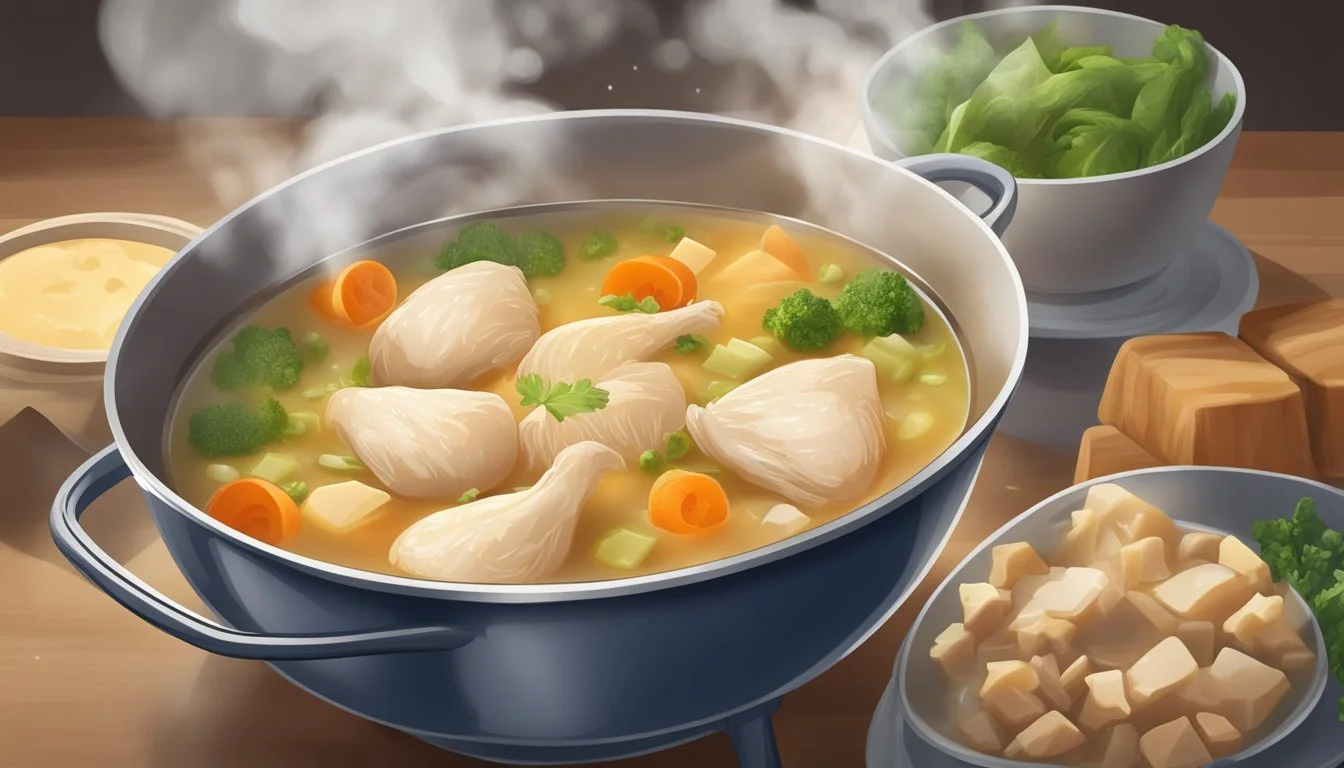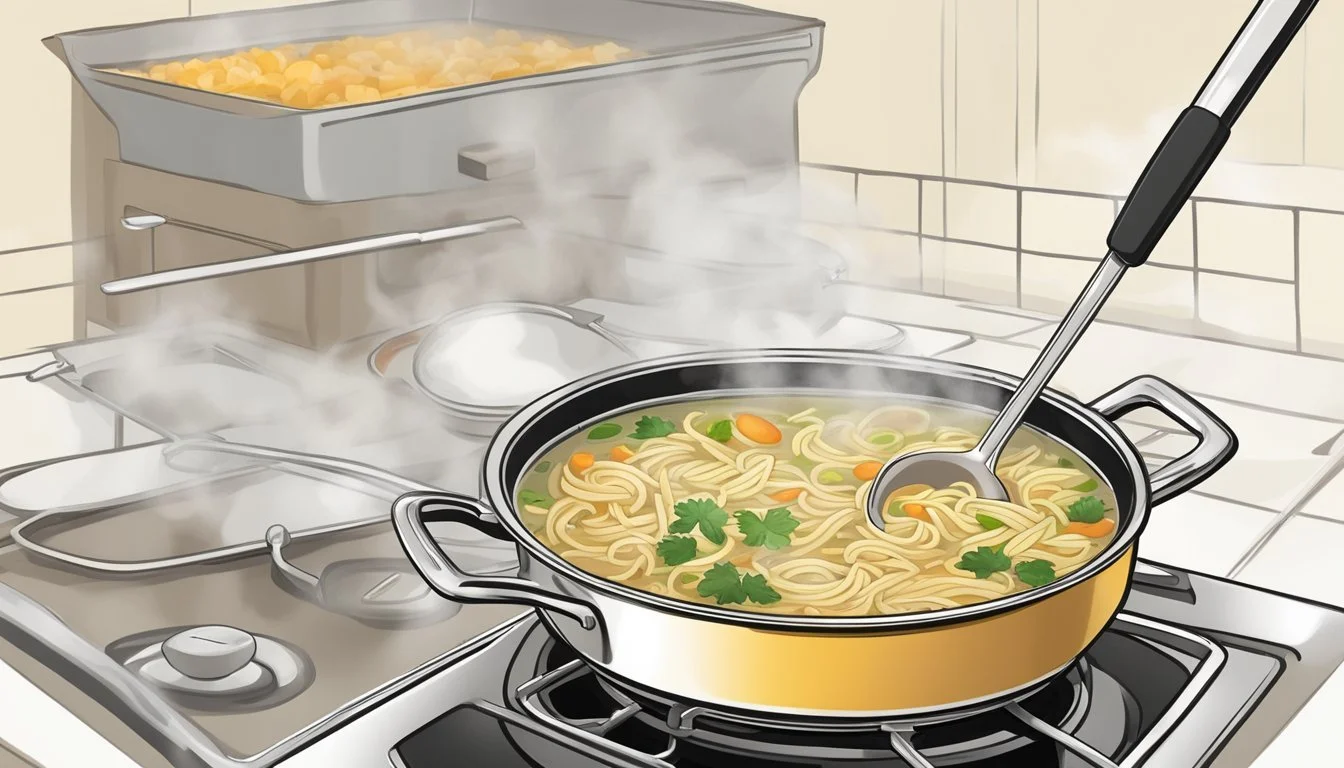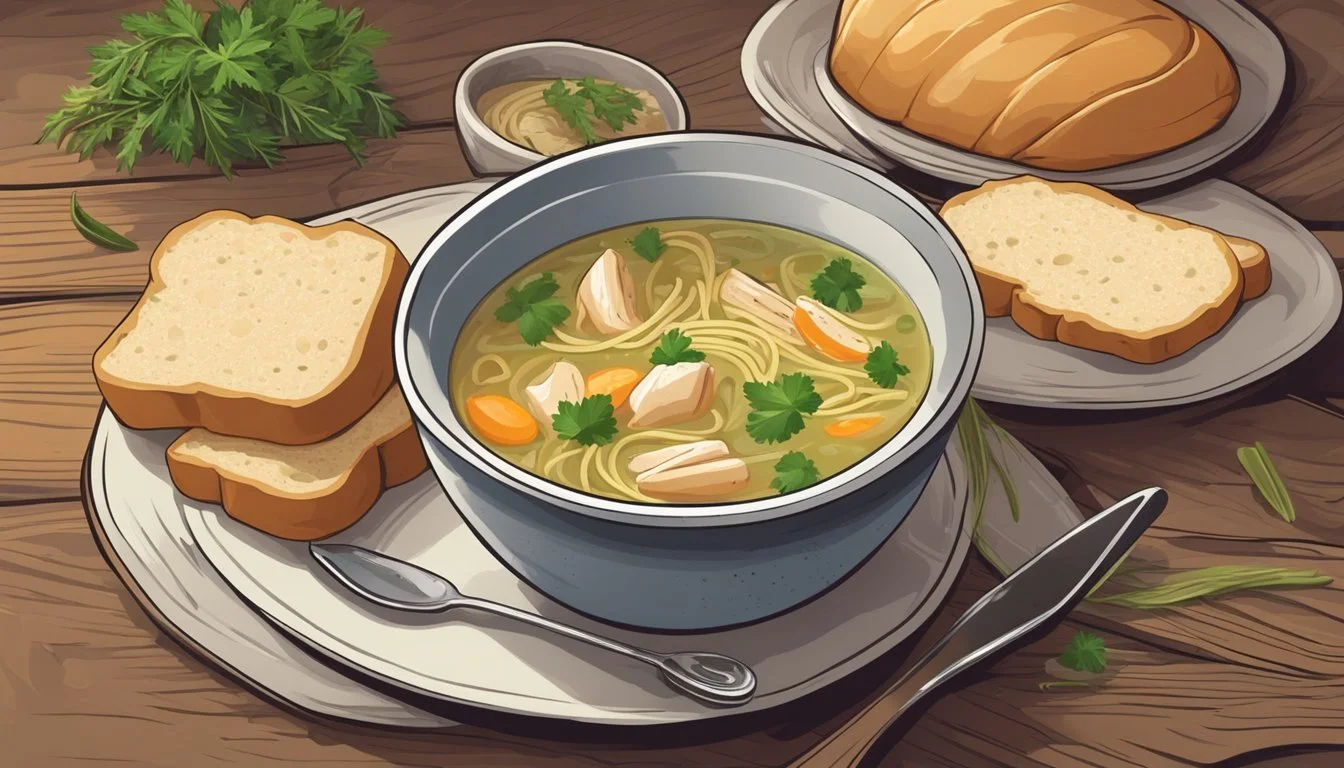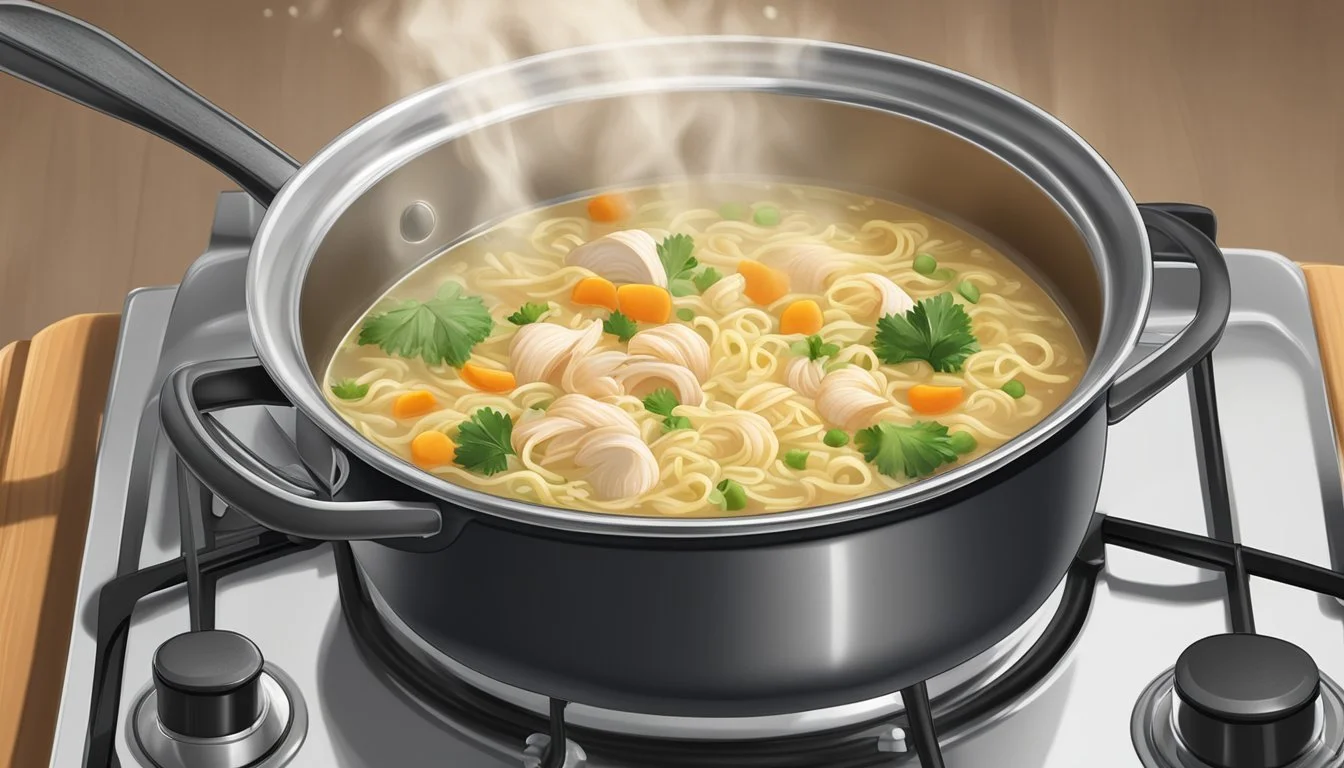How Long Does Gluten-Free Chicken Noodle Soup (No Pasta) Last?
Shelf Life and Storage Tips
Gluten-free chicken noodle soup is a comforting dinner option that many enjoy, even without the pasta. When stored properly in the refrigerator, gluten-free chicken noodle soup (no pasta) can last up to 3-4 days. It remains a hearty and delicious meal, perfect for those seeking both comfort and practicality.
This savory dish, which can be prepared with a variety of methods from stovetop to slow cooker, keeps well when stored in an airtight container. Freezing is also an option for longer storage, where the soup can last for up to three months without losing its flavor or texture.
Understanding the shelf life of this dish can help in meal planning, reducing food waste, and ensuring that you have a quick, nutritious meal ready whenever you need it. This makes gluten-free chicken noodle soup (sans pasta) an excellent choice for busy lifestyles.
Understanding Gluten-Free Chicken Soup
Gluten-free chicken soup is a nutritious and healthy option that caters to those with gluten sensitivities. This dish utilizes quality ingredients to create a hearty meal packed with essential nutrients.
Essential Ingredients
Chicken: The primary protein source is usually cubed chicken breast or shredded chicken thighs.
Broth: Chicken broth forms the base of the soup, providing a rich flavor and essential nutrients.
Vegetables: A mix of carrots, celery, onion, and garlic are typically sautéed in olive oil or butter to enhance taste and texture.
Seasonings: Herbs such as parsley and thyme, along with essentials like salt and pepper, are used to elevate the overall flavor profile.
Each of these components is chosen not only for their taste but also for their contribution to the soup’s nutritional benefits.
Nutritional Benefits
Gluten-free chicken soup is a balanced meal, particularly rich in protein from the chicken.
The vegetables provide a wealth of vitamins and minerals, contributing to a healthy diet. Carrots are a good source of Vitamin A, while celery adds fiber. Onions and garlic bring antioxidants and boost the immune system.
Using olive oil adds healthy fats, ensuring the soup is nourishing and filling. The broth ensures proper hydration and includes essential amino acids, making it a well-rounded dish for anyone seeking a gluten-free diet.
Preparation Techniques
Making gluten-free chicken noodle soup requires specific approaches to ensure the dish is both flavorful and suitable for various dietary needs. Key elements include selecting the right cooking method and choosing appropriate gluten-free pasta alternatives.
Cooking Method
A Dutch oven or large stock pot is ideal for preparing gluten-free chicken noodle soup. Begin by sautéing onions, garlic, carrots, and celery until they are tender. Use medium heat to help control the cooking process. Then, add chicken broth and bring the mixture to a boil, then reduce the heat and simmer.
For those wanting a hands-off approach, a slow cooker can be useful. After sautéing the vegetables, transfer them to the cooker along with broth and chicken. Cook on low for 6-8 hours or high for 3-4 hours. An Instant Pot is another convenient method, allowing you to sauté and pressure cook in the same pot within about 30 minutes.
Gluten-Free Pasta Alternatives
Various brands like Jovial and Barilla offer quality gluten-free pasta options. These can include rice noodles, corn and rice pasta, or quinoa-based noodles. Given that gluten-free pasta can become mushy if overcooked, it’s crucial to follow package instructions closely.
Cooking the pasta separately and adding it after the soup has cooked can prevent it from becoming overly soft. Alternatively, some recipes suggest adding cooked pasta directly into the soup before serving. This method helps maintain the texture and flavor of the noodles, providing a balanced, satisfying dish.
Using fresh gluten-free pasta can also enhance the dish. It tends to cook quickly and can be directly added to the simmering soup close to the end of the cooking process.
Storing and Preservation
Proper storage techniques can significantly extend the shelf life of gluten-free chicken noodle soup, ensuring that it remains safe to eat and retains its flavor.
Refrigeration
Refrigerate gluten-free chicken noodle soup within two hours of cooking to keep it safe from bacteria. Place the soup in an airtight container to avoid contamination and store it in the refrigerator at a temperature below 40°F (4°C).
When properly refrigerated, the soup lasts up to 3-5 days. Always reheat thoroughly to an internal temperature of 165°F (74°C) before consuming any leftovers. Splitting larger batches into smaller portions can aid in quicker cooling and easier reheating.
Freezing Tips
For longer storage, freezing is an effective method. Allow the soup to cool completely before transferring it to airtight containers or heavy-duty freezer bags. Leave space at the top of the container to allow for expansion.
Label the containers with the date of freezing. When stored properly, the soup lasts up to 2-3 months in the freezer. Thaw frozen soup in the refrigerator overnight or by using the defrost setting on a microwave before reheating. Always check for any changes in texture or smell before eating.
Serving Suggestions
Pairing gluten-free chicken noodle soup with complementary sides and garnishes can elevate the meal. From gluten-free dinner rolls to fresh herbs, there are many ways to enhance both flavor and presentation.
Accompaniments
For a heartier meal, gluten-free dinner rolls are an excellent choice. These rolls are perfect for soaking up the broth and add a satisfying texture.
A side salad with a light lemon juice vinaigrette provides freshness and balance.
Consider adding roasted vegetables like carrots and Brussels sprouts for extra warmth.
When serving family and friends, a platter of mixed olives, cheeses, and gluten-free crackers can be an appealing starter.
Garnishing Ideas
Fresh herbs like parsley and dill can brighten up the soup, offering a pop of color and an aromatic touch.
A squeeze of lemon juice just before serving can enhance the flavors, giving the soup a refreshing finish.
To add a bit of richness, drizzle a small amount of good-quality olive oil over the top.
Finely chopped green onions or chives provide a mild onion flavor and a crisp texture.
Recipe Variations
Many variations can enhance the flavor and nutritional value of gluten-free chicken noodle soup. Adding unique ingredients or incorporating cultural influences can make this classic dish even more delightful.
Non-Traditional Additions
Incorporating leftover chicken can be an excellent way to add convenience and rich flavor to the soup. Using rotisserie chicken is particularly effective, as it is already seasoned and tender. For a creamy texture without dairy, consider using coconut milk or a non-dairy cream substitute, which keeps the soup dairy-free while adding richness.
Adding vegetables like peas or kale can boost the nutritional content by providing additional vitamins and fiber. For extra collagen and protein, tossing in some bone broth instead of regular chicken broth can enhance both flavor and health benefits. Spices such as turmeric and ginger can be used to add a warm, savory depth, making the soup more flavorful and aromatic.
Cultural Twists
Different cultural influences can elevate gluten-free chicken noodle soup into a fascinating culinary experience. For an Asian-inspired variation, consider adding ingredients like ginger, soy sauce (gluten-free), and a splash of rice vinegar. Using rice noodles instead of traditional pasta can keep the dish gluten-free while adding an interesting texture.
Incorporating Mediterranean ingredients such as lemon juice, dill, and olive oil can give the soup a bright, zesty flavor. For a Mexican twist, adding cumin, cilantro, and a dash of lime juice can transform the soup into a vibrant, zesty dish.
Using these cultural elements, the soup remains simple yet refreshing, ideal for dinner or as leftovers.
Additional Tips
To make the most of gluten-free chicken noodle soup without pasta, consider exploring the use of leftover chicken and ways to enhance the flavor of the soup.
Using Leftover Chicken
Utilizing leftover chicken in gluten-free chicken noodle soup can be a fantastic shortcut. Shredded chicken from previous meals can be easily incorporated. Both chicken breasts and boneless, skinless chicken thighs work well.
For best results, shred the cooked chicken finely before adding it to the soup. This ensures a consistent texture throughout. When repurposing chicken, be mindful of its original seasoning to avoid overpowering the soup. If the chicken was already seasoned with herbs like oregano or bay leaf, it can enhance the flavor of your soup.
Leftover chicken should be added towards the end of cooking to prevent it from becoming too dry or tough. It only needs to be heated through, typically a matter of minutes.
Enhancing Flavor
Creating a flavorful chicken broth is key. Begin by sautéing minced garlic, carrots, onions, and celery in olive oil or butter until they are soft and fragrant. This base layer adds depth.
Consider adding dried oregano, bay leaves, and black pepper to boost the soup’s aroma. Seasoning should be adjusted to taste, keeping the broth balanced. Using chicken thighs or chicken breasts that have been simmered in the broth can also enrich the flavor.
For additional richness, a splash of gluten-free soy sauce or a squeeze of lemon juice can add complexity. Cook the soup at a low simmer to meld the flavors without reducing the broth too much. This ensures the soup remains light yet full-flavored.








